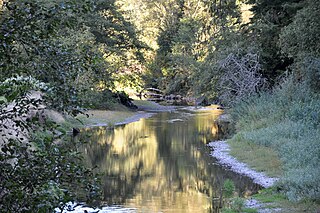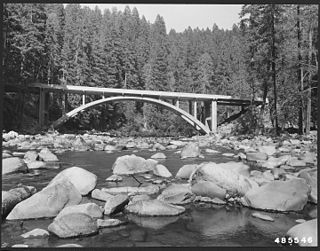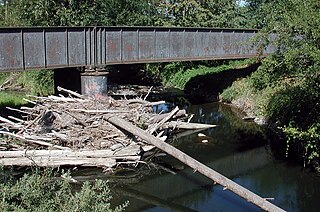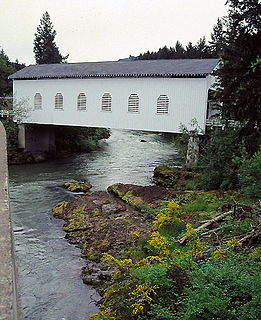| Little Luckiamute River | |
|---|---|
 Rapids on the Little Luckiamute River | |
| Etymology | Native American but of unknown meaning [1] |
| Location | |
| Country | United States |
| State | Oregon |
| County | Polk |
| Physical characteristics | |
| Source | Central Oregon Coast Range |
| - location | near Fanno Peak |
| - coordinates | 44°52′45″N123°37′37″W / 44.87917°N 123.62694°W [2] |
| - elevation | 2,869 ft (874 m) [3] |
| Mouth | Luckiamute River |
| - location | about 4 miles (6 km) upstream of Sarah Helmick State Recreation Site |
| - coordinates | 44°47′28″N123°17′17″W / 44.79111°N 123.28806°W Coordinates: 44°47′28″N123°17′17″W / 44.79111°N 123.28806°W [2] |
| - elevation | 203 ft (62 m) [2] |
| Length | 24 mi (39 km) [4] |
| Discharge | |
| - location | Helmick State Recreation Site, 13.5 miles (21.7 km) from the mouth |
| Basin features | |
| Basin size | 54 sq mi (140 km2) [5] |
The Little Luckiamute River is a stream in Polk County in the U.S. state of Oregon. It rises in the Central Oregon Coast Range near Fanno Peak and joins the Luckiamute River about 4 miles (6 km) upstream of the Sarah Helmick State Recreation Site southwest of Monmouth. [4]

Polk County is a county located in the U.S. state of Oregon. As of the 2010 census, the population was 75,403, making it the least populous county in the Willamette Valley. The county seat is Dallas. The county is named for James Knox Polk, the 11th president of the United States.

Oregon is a state in the Pacific Northwest region on the West Coast of the United States. The Columbia River delineates much of Oregon's northern boundary with Washington, while the Snake River delineates much of its eastern boundary with Idaho. The parallel 42° north delineates the southern boundary with California and Nevada. Oregon is one of only three states of the contiguous United States to have a coastline on the Pacific Ocean.

The Central Oregon Coast Range is the middle section of the Oregon Coast Range, in the Pacific Coast Ranges physiographic region, and located in the west-central portion of the state of Oregon, United States roughly between the Salmon River and the Umpqua River and the Willamette Valley and the Pacific Ocean. This approximately 90-mile (140 km) long mountain range contains mountains as high as 4,097 feet for Marys Peak. Portions of the range are inside the Siuslaw National Forest and three wilderness areas exist as well: Drift Creek Wilderness, Cummins Creek Wilderness and Rock Creek Wilderness.
Contents
Flowing generally east from its source near Fanno Peak, the river parallels Fanno Ridge, which is to the right. Lost Creek enters from the left at a rapids, and Camp Creek enters from the left 20.6 miles (33.2 km) from the mouth. About 0.5 miles (0.80 km) further on, the river passes over a waterfall. Approaching the unincorporated community of Black Rock, Little Luckiamute River receives Black Rock Creek from the left at river mile (RM) 17 or river kilometer (RK) 27. For several miles starting at Black Rock, the George T. Gerlinger Experimental Forest is on the river's left. Sam's Creek enters from the left about 1 mile (1.6 km) downstream of Black Rock. [4] [6]
Black Rock is an unincorporated community and former logging camp in Polk County, Oregon, United States. It is located about three miles west of Falls City, in the Central Oregon Coast Range on the Little Luckiamute River.

In the United States, a river mile is a measure of distance in miles along a river from its mouth. River mile numbers begin at zero and increase further upstream. The corresponding metric unit using kilometers is the river kilometer. They are analogous to vehicle roadway mile markers, except that river miles are rarely marked on the physical river; instead they are marked on navigation charts, and topographic maps. Riverfront properties are sometimes partially legally described by their river mile.
George T. Gerlinger was influential in the railroad and lumber products business in the U.S. state of Oregon in the early 20th century. The oldest son of Louis Gerlinger, Sr., in 1902 he organized a group of investors in Dallas, Oregon to build railroad lines in the area.
Gerlinger County Park is on the right at RM 15 (RK 24). Dutch Creek enters from the left and Berry Creek from the right before the river reaches Falls City Falls and Falls City about 13 miles (21 km) from the mouth. [4] [6] At the falls, the river plunges 25 to 35 feet (7.6 to 10.7 m) into a gorge within a city park. [7] Turning southeast, the river receives Waymire Creek from the left, then Teal Creek from the right, then passes under Oregon Route 223 at about RM 8 (RK 13). Fern Creek enters from the left just beyond Route 223, and Cooper Creek enters from the left about 1.5 miles (2.4 km) from the mouth. The Little Luckiamute River meets the Luckiamute River about 18 miles (29 km) from the larger river's confluence with the Willamette River. [4] [6]

Falls City is a city in Polk County, Oregon, United States. The population was 947 at the 2010 census. It is part of the Salem Metropolitan Statistical Area.

Oregon Route 223 is a state highway in the U.S. State of Oregon, which runs between the town of Wren, Oregon and the city of Dallas, Oregon. It is known as the Kings Valley Highway No. 191 and is 31 miles (50 km) long. It lies in Benton and Polk counties.

The Willamette River is a major tributary of the Columbia River, accounting for 12 to 15 percent of the Columbia's flow. The Willamette's main stem is 187 miles (301 km) long, lying entirely in northwestern Oregon in the United States. Flowing northward between the Oregon Coast Range and the Cascade Range, the river and its tributaries form the Willamette Valley, a basin that contains two-thirds of Oregon's population, including the state capital, Salem, and the state's largest city, Portland, which surrounds the Willamette's mouth at the Columbia.
The upper river supports catch-and-release fishing for wild coastal cutthroat trout ranging in size from 6 to 13 inches (15 to 33 cm). [8]
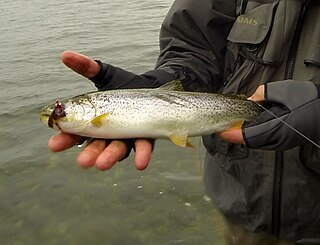
The coastal cutthroat trout also known as the sea-run cutthroat trout, or harvest trout is one of the several subspecies of cutthroat trout found in Western North America. The coastal cutthroat trout occurs in four distinct forms. A semi-anadromous or sea-run form is the most well known. Freshwater forms occur in both large and small rivers and streams and lake environments. The native range of the coastal cutthroat trout extends south from the southern coastline of the Kenai Peninsula in Alaska to the Eel River in Northern California. Coastal cutthroat trout are resident in tributary streams and rivers of the Pacific basin and are rarely found more than 100 miles (160 km) from the ocean.








